Atlixco, Puebla 作者: 来源: 发布时间:2021-11-15
1.Population and Area
Pop: 125,000 (munip.)
Area: 229.22 km2 (munip.)
Elev: 1,035 masl

Atlixco location in Mexico within the state of Puebla
https://goo.gl/maps/Rs2aQCvP98Wy4kes5
2. Natural geography
Nature and weather
The territory of the municipality is divided between the Valley of Puebla and the Atlixco Valley, both of which extend from the Sierra Nevada. The altitude varies from a low of 1,700 meters above sea level in the south to 2,500 in the northwest at the foot of the Iztaccihuatl Volcano, with an overall average altitude of 1840. The center of the territory is a valley floor that extends from north to south, with isolated mountains such as Zoapiltepec and Texistle in the southeast. Other isolated peaks include the Pochote, Tecuitlacuelo, Loma La Calera and El Charro.
The municipality is located in the basin of the Nexapa River, a tributary of the Atoyac. Various streams run through the territory, which have their source at the Iztaccihuatl Volcano; however, most depending on snow melt from the volcano. The Nexcapa is one of the few that run year-round and splits the Atlixco Valley in half. Other larger ones include the Cuescomante, which passes by the seat, the Molino and the Palomas. The highest elevations at the foot of the volcanos are marked by a large number of ravines. The San Pedro Atlixco Waterfall is in this area, surrounded by pines and cedars. This area has fishing, boating, camping and more.
The original flora in most of the region has been altered by man, but there are still undisturbed zones composed of cedars, pine, grasslands, ahuehuetes, palms and magueys or teaspoons; low deciduous forest and thorn scrub.
There are mineral beds that produce barite, clay, limestone, gold, silver, lead, copper, gypsum, white marble, iron and coal, but not all of them exploit them with intensity.
The original fauna, which still exists, is made up of different species of birds, skunks, rabbits, squirrels, scorpions, vipers and spiders.
Köppen Classification: Tropical Savanna Climate
This climate is characterized by relatively high temperatures and evenly distributed precipitation throughout the year. This climate type is found on the eastern sides of the continents between 20° and 35° N and S latitude. In summer, these regions are largely under the influence of moist, maritime airflow from the western side of the subtropical anticyclonic cells over low-latitude ocean waters. Temperatures are high and can lead to warm, oppressive nights. Summers are usually somewhat wetter than winters, with much of the rainfall coming from convectional thunderstorm activity; tropical cyclones also enhance warm-season rainfall in some regions. The coldest month is usually quite mild, although frosts are not uncommon, and winter precipitation is derived primarily from frontal cyclones along the polar front.
The Köppen Climate Classification subtype for this climate is "Cfa". (Humid Subtropical Climate).
The average temperature for the year in Atlixco is 64.9°F (18.3°C). The warmest month, on average, is May with an average temperature of 68.7°F (20.4°C). The coolest month on average is January, with an average temperature of 60.4°F (15.8°C).
The highest recorded temperature in Atlixco is 102.2°F (39°C), which was recorded in March. The lowest recorded temperature in Atlixco is 30.2°F (-1°C), which was recorded in January.
The average amount of precipitation for the year in Atlixco is 34.1" (866.1 mm). The month with the most precipitation on average is August with 7.0" (177.8 mm) of precipitation. The month with the least precipitation on average is December with an average of 0.1" (2.5 mm). In terms of liquid precipitation, there are an average of 93.4 days of rain, with the most rain occurring in August with 17.1 days of rain, and the least rain occurring in December with 0.7 days of rain.
https://www.weatherbase.com/weather/weather-summary.php3?s=921012&cityname=Atlixco%2C+Puebla%2C+Mexico&units=
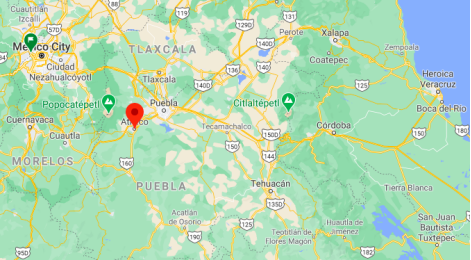
Getting there and around
Get there
By car – The cheapest way to get from Mexico City to Atlixco is to drive which costs $280 - $410 and takes 1h 57m.
The distance between Mexico City and Atlixco is 93 km. The road distance is 150.7 km.
By bus – The best way to get from Mexico City to Atlixco without a car is to bus which takes 3h 42m and costs $460 - $600. It takes approximately 3h 42m to get from Mexico City to Atlixco, including transfers.
https://www.rome2rio.com/s/Mexico-City/Atlixco
Car Rental – To explore Mexico’s provincial towns and cities—including its beach locations and the scenery and attractions near them— consider renting a car for your visit. Having your own car will give you more flexibility than using public transport options and, in some cases, offer you access to places which are otherwise difficult to visit without the use of a car.
COVID19 – International entry into Mexico from United States
Allowed for: All visitors arriving by air. Mexico land borders are closed to non-essential travel
Restricted for: There are no current restrictions.
Get around
Local Buses – Local buses and mini-buses (combis or micros) are available locally for a fraction of the cost of a taxi around town. You need to speak Spanish to be able to ask for directions or ask the driver to tell you where to get off.
Taxis – Taxis in most of Mexico’s towns and cities are not metered, so agree your price before you get in. Taxi travel is very affordable in Mexico, in comparison to the USA, Canada and Europe, and so provides a viable means of public transportation in Mexico. Your hotel can arrange taxis for you; some post their rates on a board in the lobby; taxi hotel rates are usually higher than cabs you hail off the street. If you speak Spanish, you will have a distinct advantage and be able to negotiate a price with the driver.
Uber is expanding rapidly across Mexico and now offers services in cities across the country, including: Mexico City, Toluca, Cuernavaca, Puebla, Querétaro, León, Aguascalientes, San Luis Potosí, Guadalajara, Monterrey, Hermosillo, Tijuana, Mexicali, and Mérida. Uber has been adding Mexican cities to its network every year, check for availability when you arrive at your destination in Mexico.
Cabify and Didi are also developing and currently operate in cities including Mexico City, Toluca, Monterrey, Puebla, Querétaro and Tijuana. Check for availability in the city you are visiting.
These services offer people with smartphones a way to book a cab through a mobile app for a pre-agreed price. Fares are comparable with Sitio type cabs, and sometimes trade at a premium to this when local demand increases.
https://www.mexperience.com/transport/taxi-travel-in-mexico/#51
3. ECONOMY
GDP: 6 696.2 M MXN (2010)
https://www.scribd.com/document/395710620/Dialnet-ElProductoInternoBrutoDeLosMunicipiosDeMexicoIIEst-4954700-pdf
4. Industry characteristics
The city of Atlixco is a regional commercial, manufacturing and industrial center with textile mills, distilleries and bottling plants. Traditional handcrafts also are made here and in the rest of the municipality including ceramic utensils, embroidered shirts and blouses and candles.
However, the municipality is best known for its cultivation of ornamental plants, flowers and fruit trees. Flowers include roses, geraniums, chrysanthemums, and Cornish mallow (Lavatera cretica) . All of its potted plant production is sold in Mexico, with eighty percent of the cut flowers sent abroad, mostly to the United States.
The municipality ranks first in the production of roses and gladiolas and is one of the largest producers of poinsettias, helping to make the state of Puebla fourth in Mexico in its production. Fifty two producers on twenty five hectares typically produce 1.5 million poinsettials per year. Sales from poinsettias alone reach at least 68 million pesos for the municipality and support 800 families. Most of the plants are shipped to other Mexican states such as Veracruz, Oaxaca, Chiapas, Yucatán and Campeche. The main flowers grown and sold for Day of the Dead include chrysanthemums, gladiolas and baby's breath.
In addition, other crops such as wheat, corn, beans and fruits, much of which are processed locally and distributed from the city.
The state government, which has tendered 1,000 patrols for state security, will designate a specific number of these for the municipality of Atlixco. Additionally, weapons acquired from the Ministry of National Defense will be delivered.
The beautification project includes restoring facades, repainting buildings throughout the area, rehabilitating the theater where the Huey Atlixcáyotl Festival is held, and building a site museum on the San Miguel hill, in order to promote this celebration at the national and national level. international.
Parallel and complementary to this project, it is planned to build an inter-municipal waste treatment plant for the Atlixco region.
https://www.parabolica.mx/2019/local/item/29077-anuncian-proyecto-de-embellecimiento-del-centro-historico-de-atlixco
5. Attractions
Archaeological Zone of Xochicalco
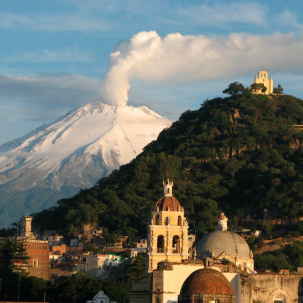
If you visit the Pueblo Magico of Atlixco you cannot miss conquering Cerro de San Miguel (San Miguel’s peak). You can reach it by foot, if you’re in good shape, or by car.
Reward of climbing up will be an incredible Atlixco and surrounding nurseries 360° postcard view. Here is also located the San Miguel chapel. Finding it closed is a common thing, since it only opens its doors on September 29th when the Arcángel festival is celebrated.
If you’re looking for a bit of adrenaline, we recommend you get on a swing located on the shore of hill’s top. If you manage to overcome vertigo and swing a couple times, we assure you that you’ll feel as if you were flying over Atlixco.
https://www.visitmexico.com/en/puebla/atlixco/cerro-de-san-miguel-san-miguels-peak
Greenhouses
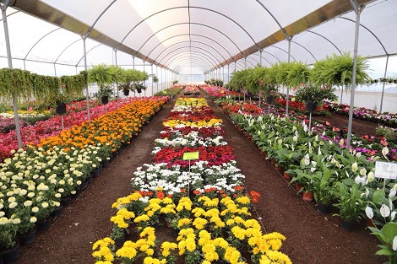
Two of Atlixco's boasty attributes are their fertile land and climate—poblanos assure is one of the best in the world. These conditions mean that, in addition to harvesting different species, families dedicate themselves to growing plants and flowers. Orchids are one of the species that attract visitors and even collectors.
Taking care of the greenhouse or garden center is a family activity, so it’s common that knowledge about plant care was transmitted from grandparents to next generations.
Each of these spaces is colored in different shades thanks to the species variety they offer, which we can take home at a low price buying directly to their producers. , which is why the people of Puebla assure that it is one of the best in the world.
These conditions mean that in addition to harvesting different species, the families dedicate their time to growing plants and flowers. One of the species that attract visitors and even collectors, are the orchids.
Taking care of the greenhouse or nursery is a family activity, so it is common for knowledge about plant care to be transmitted from grandparents to the next generations.
Each one of these species are colored in different shades thanks to the variety of spaces they offer, which we can take home at a low price and buying directly from their producers.
https://www.visitmexico.com/en/puebla/atlixco/greenhouses
Villa Iluminada
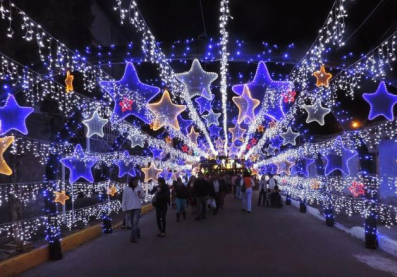
Every year, Atlixco becomes an authentic Christmas Village just like those described in stories or watch in movies.
Annually, the illuminated Atlixco village opens its doors to children and adults for 40 nights—from late November to early January. From different parts of the country, families travel to this city in Puebla to enjoy a winter experience that includes a train with Santa Claus.
This magic is possible thanks to local artisans work—they help to design the figures installed each edition. The surprising tunnels and illuminated figures tour begins in city’s Zócalo and reaches almost 2 kilometers. Illuminated Village’s visitors might go around the Feria de la Nochebuena, which takes place annually between the last week of November and December first week.
https://www.visitmexico.com/en/puebla/atlixco/villa-iluminada
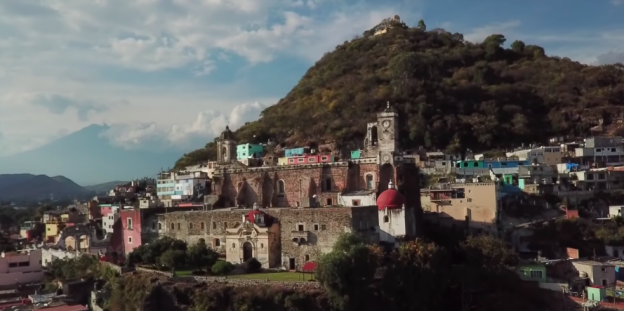
CHOLULA vs ATLIXCO, PUEBLA. Which is the BEST PUEBLO MAGICO?
https://youtu.be/swi2l2xhEoM
6. History
The name “Atlixco” comes from a Nahuatl phrase which can be interpreted as either “water in the valley” or “water on the ground.” Its main economic activity has earned the city the suffix of “de las flores” (of the flowers) . The city of Atlixco received its coat of arms from King Phillip II in 1579, which now represents the entire municipality.
In the pre Hispanic period, it was part of Cuauhquecollán, today Huaquechula. The first known inhabitants of this area were the Teochichimecas around 1100CE, before becoming a Xicalanca settlement. This area was eventually conquered by Tenochtitlan. Its location made it a battleground among several indigenous peoples, with the populations of Calpan, Huejotzingo and Cholula claiming possession. After the Conquest it was named Acapetlahuacan (place of reeds) until its current name.
During the colonial period, the area was an important producer of grain, especially wheat, giving rise to the first wheat mill in the state. The city proper was founded in 1579 as Villas de Carrión by Pedro de Castillo, Cristóbal Ruiz de Cabrera and Alonso Díaz de Carrión. Originally it and the surrounding area was under the jurisdiction of Huejotzingo, but in 1632, it became a local independent seat of government.
In 1706 the area became under the direct control of the Spanish Crown, with Philip V granting José Sarmiento de Valladares the title of Duque y Señor de Atlixco.
In 1840 the Marquesa Calderón de la Barca visited the community and noted that it was filled with beautiful churches, monasteries and other buildings.
The town was given the official status of city by Nicolás Bravo in 1843. In 1847, the municipal government took over administration of the San Juan de Dios Hospital. In 1862, troops led by General Tomás O´Horan defeated French sympathizers under Leonardo Márquez, impeding the advance of French troops. This was an important precursor to the Battle of Puebla .
Since then the area's economy has changed to the production of flowers and ornamental plants along with some commerce and industry. There have also been efforts to make the area attractive for tourists, with various festivals and other events established since the late 20th century.
7.Contact Information
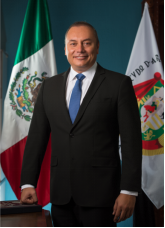
City Mayor: José Guillermo Velázquez Gutiérrez
Contact number: +52 (244) 445 3406
Govt. Office Address: Plaza de Armas No. 1, Col. Centro, Atlixco, Pue.
FB: https://www.facebook.com/MemoVelazquezMX
Twitter: https://twitter.com/memovelazquezmx
Website: https://oficial.atlixco.gob.mx
